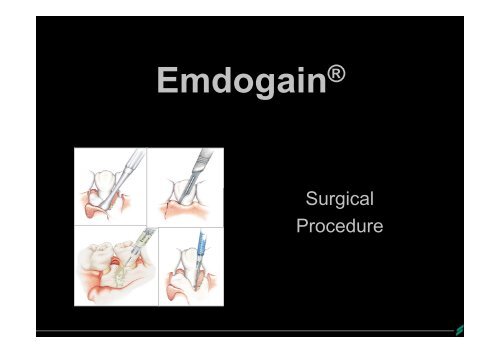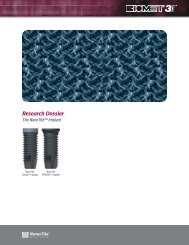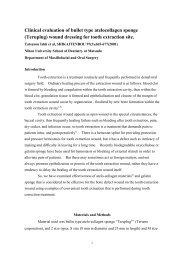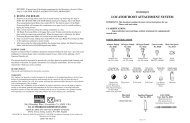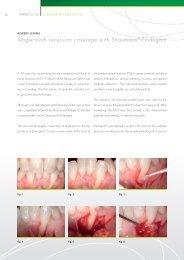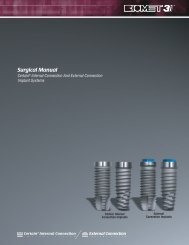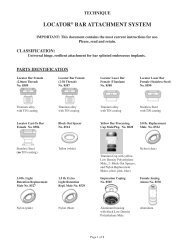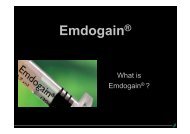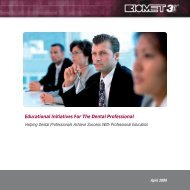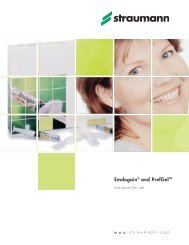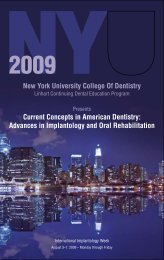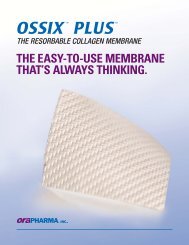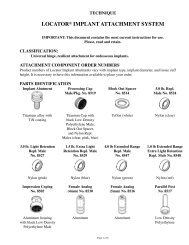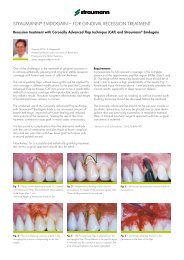Treatment with Emdogain
Treatment with Emdogain
Treatment with Emdogain
Create successful ePaper yourself
Turn your PDF publications into a flip-book with our unique Google optimized e-Paper software.
<strong>Emdogain</strong> ®<br />
Surgical<br />
Procedure<br />
INFO
<strong>Treatment</strong> <strong>with</strong> <strong>Emdogain</strong> ® Root cement<br />
Periodontal<br />
ligament<br />
Alveolar bone<br />
(Gingival)
Pre Surgical procedure<br />
Careful patient selection:<br />
Oral hygiene, smoking etc.<br />
• Cleaning, scaling, reducing degree of inflammation<br />
• Follow up after 2-3 month, measurement of PD, tooth<br />
stability<br />
Periodontal disease has to be eliminated
Surgical procedure<br />
• Remove any remaining plaque and/or calculus as<br />
well as blood from root surfaces exposed during<br />
periodontal surgery<br />
• Apply PrefGel onto exposed root surfaces<br />
for 2 minutes<br />
• Rinse thoroughly <strong>with</strong> sterile saline<br />
• Avoid recontamination of the conditioned root<br />
surfaces after the final rinse and prior to treatment<br />
<strong>with</strong> <strong>Emdogain</strong> ®
Surgical procedure<br />
incision<br />
flap elevation scaling, root planing
Surgical procedure<br />
conditioning application suturing
A small access flap, just large enough for<br />
instrumentation and good view
Reflection of soft tissues to expose<br />
periodontal defect
Final debridement of root surface
Root surface conditioning <strong>with</strong> PrefGel
Rinsing <strong>with</strong> sterile saline<br />
Maintain surface<br />
free of blood<br />
and / or saliva
Application of <strong>Emdogain</strong> ®
Modified mattress suture
Soft tissues replaced in preoperative<br />
position and sutured
Postsurgical follow-up/maintenance<br />
Day of operation:<br />
• Start rinsing <strong>with</strong> chlorhexidine solution (0.2-0.12%)<br />
• Refrain from/minimize smoking<br />
• Do not brush the area of the operation<br />
• Avoid hard and crispy food<br />
• (Antibiotics, if deemed appropriate based on the<br />
• clinician’s judgement)<br />
Wound stability & infection control
Postsurgical follow-up/maintenance<br />
Week 1 postsurgery:<br />
• Removal of sutures which no longer add to the<br />
stability of the healing wound<br />
• “Professional tooth cleaning” as needed<br />
• Continue to rinse <strong>with</strong> chlorhexidine solution<br />
(or to apply chlorhexidine gel locally in<br />
the operated area)
Postsurgical follow-up/maintenance<br />
2 - 6 weeks postsurgery:<br />
• Removal of any remaining sutures<br />
• “Professional tooth cleaning” as needed<br />
• Continue to rinse <strong>with</strong> chlorhexidine solution<br />
(or to apply chlorhexidine gel locally in<br />
the operated area)<br />
• Week 4 start careful toothbrushing in the operated<br />
area on buccal/lingual surfaces, but not<br />
interproximally
Postsurgical follow-up/maintenance<br />
6 weeks postsurgery:<br />
• Stop rinsing <strong>with</strong> chlorhexidine<br />
• “Professional tooth cleaning” as needed<br />
• Start interproximal tooth cleaning in the<br />
operated area<br />
• Fluoride application as needed<br />
• Decide on subsequent (individual) recall schedule
Postsurgical follow-up/maintenance<br />
6 to 12 months<br />
• Adequate tooth cleaning in the<br />
operated area<br />
• Decide on subsequent (individual) recall schedule<br />
• x-rays at 12 months
Postsurgical follow-up<br />
• No probing before 6 months !<br />
• Follow-up radiographs at<br />
12 and 24 months<br />
• Individual recall program


